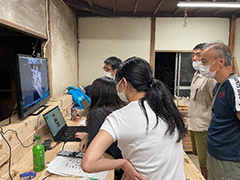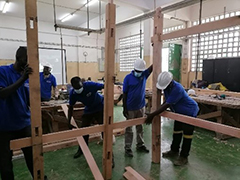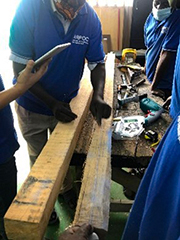Using traditional Japanese construction methods to foster reconstruction leaders in Mozambique! - KIGUMI Technical Training -
2022.03.22
In September and October 2021, a Kigumi woodworking training course (3 days remote, 2 days follow-up in person) was conducted for a total of 20 carpenters, training schoolteachers, and Beira Municipality staffs in Beira city. "Kigumi" is a Japanese traditional construction method which joints wood by carving out each wood piece with no support of nails or metal fittings, and this allows repetitive assembling and disassembling. ARPOC planned to introduce such construction method to a fish market which was heavily damaged by Cyclone Idai in 2019, with expectation of the market users able to disassemble and remove in advance to a landfall of a cyclone and reassemble soon after to improve the disaster mitigation of the market. The Kigumi technique is continued be disseminated locally.
The purpose of this training program is to help local carpenters learn the environmentally friendly technique of wood framing, which is excellent for both assembly and disassembly. The participants were carpenters and teachers from technical training schools in Beira, who are crucial in the dissemination of woodworking techniques. The training dealt with "stall" which can contribute to the strengthening of fish markets and facilitate understanding of the Kigumi structure. On the first and second days of the training, participants practiced wood processing, and on the last day, they practiced assembling and disassembling with the processed materials. In organizing this training, a working group consisting of Praia Nova fish market officials, carpenters from the surrounding area, and members of the Beira Municipality had been preparing for this training after months of discussions and exchanges of ideas. There were many issues to be discussed, such as the extent to which training could be provided remotely, the scope and difficulty of the content, the target participants, and what preparations would be necessary, but thanks to the active exchange of opinions by the WG members, the training came to real.

Working group includes various organizations.

Members' interest and willingness to participate is high.

Mr. Usui, the Japanese Kigumi veteran carpenter taught us the basics of Kigumi enthusiastically.

Mr. Usui got a photogenic shot of his tools! Top picture of the textbook found.
The long-awaited first day of the training began with words from the mayor of Beira and the head of Beira's Commerce and Industry Department, who had planned and organized this training, and was even featured in the local media, drawing the attention and support of many people.
Since neither the participants nor the project team had any experience in remote training, we asked local staff to facilitate the training on the first day to minimize the time lag in interpretation and proceeded with step-by-step explanations using the textbook and videos we had prepared in advance. From the second day onward, we tried to make the training more interactive by including a live streaming to directly convey the details of the techniques. Despite the unfamiliarity of the work, the participants were so highly motivated and focused that they had to put off their breaks, and the project team was overwhelmed by their enthusiasm.
On the last day of the training, the participants not only practiced and acquired skills, but also had a chance to think about and discuss how to utilize and disseminate the acquired woodworking skills. The team was very active in asking questions and offering opinions in response and this must have raised the motive and awareness of the future development of the techniques in Mozambique.

Textbooks are distributed in prior to the training. It gives precise description of processing wood.

Many participants brought their homework on the first day of the training.

Kigumi training being broadcasted on local news.

First session was lecture, the second through fourth sessions were for practical training.

Participants of the training gathered from different regions so had them work in pairs to encourage interactions among them.

Participants were motivated enough to try the Japanese style of chiseling.

While keeping an eye on the training on the big screen, we also kept in touch with local staff via SNS to ensure timely support and instruction.

Wooden frames cannot be assembled unless both mortise holes and through-holes are properly processed. The assembly was done through trials and errors.

Participants successfully completed assembling two sets of stalls. The participants spontaneously applauded with great smiles on their faces.

All participants were awarded with completion certificates.
From the preparation to the implementation of this training program, there were indeed many obstacles. In addition to the language barrier and local literacy rate, we were plagued with many problems each time we tried to contact the participants, such as unstable local Internet and limited means of communication with the people involved.
Among these, the most difficult part was to deal with ongoing situation flexibly during the remote training. In preparing the teaching materials (textbooks and videos), opinions of WG members were absorbed and reflected to improve easiness in understanding, resulting in taking into consideration the differences in lumber types and carpentry tools obtainable. However, during the actual training, the inaccuracy of local processed lumber and carpentry tools, and differences in the mindset of "care for center of pieces" were brought to light that could not be grasped in the preliminary survey. The project team had to make decision in partially changing the training contents in the limited time that comes from the time difference as well as time-lag for translation, and limited method which comes from the "remote" situation. Remote training makes flexible responses to beyond another level.
To avoid facing such hardcore-flexibility and to conduct the most effective and efficient training for the participants, the most important thing is to establish a deep and strong relationship between the participants and the project team before and during the training. To establish trustworthy relationship through screens require unique skill and it is likely to be disregarded when face-to-face is possible.

During the training, distortions/inaccuracy in the local wood is found and new content of figuring out the center of each wood piece had to be added. Participants are trying their best to follow the training.

In order to teach how to obtain the center of wood materials which was added to training contents due to finding out about inaccuracy of local wood, Mr. Usui demonstrates while other members struggled to deliver show in the most effective way, making full use of a smartphone camera and PC microphone.
My hope is that carpenters in Mozambique will obtain woodworking techniques and make a livelihood out of it. As pioneers of woodworking in Mozambique, I hope that the participants of this training course will continue to improve their skills and knowledge with a high level of awareness, and that in the future they will contribute to the reconstruction and resilience of Mozambique through their own efforts.
scroll